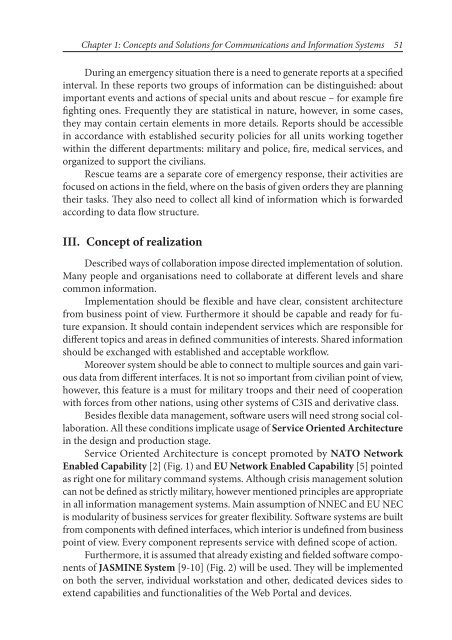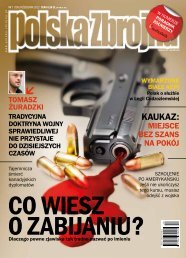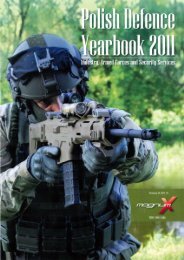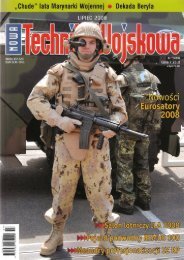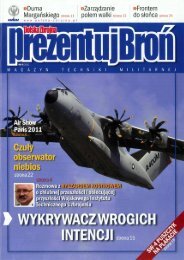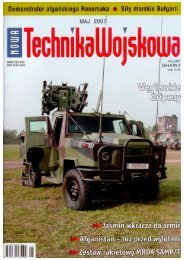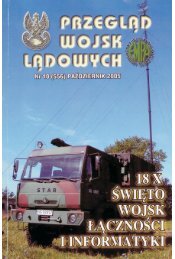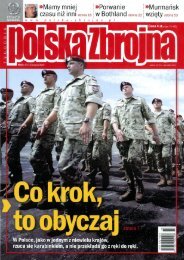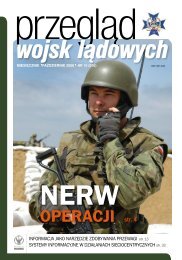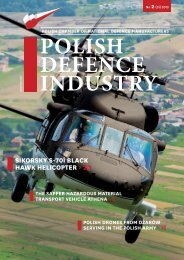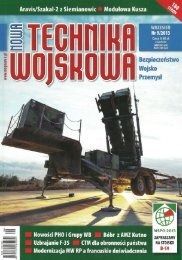Military Communications and Information Technology: A ... - TELDAT
Military Communications and Information Technology: A ... - TELDAT
Military Communications and Information Technology: A ... - TELDAT
- No tags were found...
Create successful ePaper yourself
Turn your PDF publications into a flip-book with our unique Google optimized e-Paper software.
Chapter 1: Concepts <strong>and</strong> Solutions for <strong>Communications</strong> <strong>and</strong> <strong>Information</strong> Systems51During an emergency situation there is a need to generate reports at a specifiedinterval. In these reports two groups of information can be distinguished: aboutimportant events <strong>and</strong> actions of special units <strong>and</strong> about rescue – for example firefighting ones. Frequently they are statistical in nature, however, in some cases,they may contain certain elements in more details. Reports should be accessiblein accordance with established security policies for all units working togetherwithin the different departments: military <strong>and</strong> police, fire, medical services, <strong>and</strong>organized to support the civilians.Rescue teams are a separate core of emergency response, their activities arefocused on actions in the field, where on the basis of given orders they are planningtheir tasks. They also need to collect all kind of information which is forwardedaccording to data flow structure.III. Concept of realizationDescribed ways of collaboration impose directed implementation of solution.Many people <strong>and</strong> organisations need to collaborate at different levels <strong>and</strong> sharecommon information.Implementation should be flexible <strong>and</strong> have clear, consistent architecturefrom business point of view. Furthermore it should be capable <strong>and</strong> ready for futureexpansion. It should contain independent services which are responsible fordifferent topics <strong>and</strong> areas in defined communities of interests. Shared informationshould be exchanged with established <strong>and</strong> acceptable workflow.Moreover system should be able to connect to multiple sources <strong>and</strong> gain variousdata from different interfaces. It is not so important from civilian point of view,however, this feature is a must for military troops <strong>and</strong> their need of cooperationwith forces from other nations, using other systems of C3IS <strong>and</strong> derivative class.Besides flexible data management, software users will need strong social collaboration.All these conditions implicate usage of Service Oriented Architecturein the design <strong>and</strong> production stage.Service Oriented Architecture is concept promoted by NATO NetworkEnabled Capability [2] (Fig. 1) <strong>and</strong> EU Network Enabled Capability [5] pointedas right one for military comm<strong>and</strong> systems. Although crisis management solutioncan not be defined as strictly military, however mentioned principles are appropriatein all information management systems. Main assumption of NNEC <strong>and</strong> EU NECis modularity of business services for greater flexibility. Software systems are builtfrom components with defined interfaces, which interior is undefined from businesspoint of view. Every component represents service with defined scope of action.Furthermore, it is assumed that already existing <strong>and</strong> fielded software componentsof JASMINE System [9-10] (Fig. 2) will be used. They will be implementedon both the server, individual workstation <strong>and</strong> other, dedicated devices sides toextend capabilities <strong>and</strong> functionalities of the Web Portal <strong>and</strong> devices.


